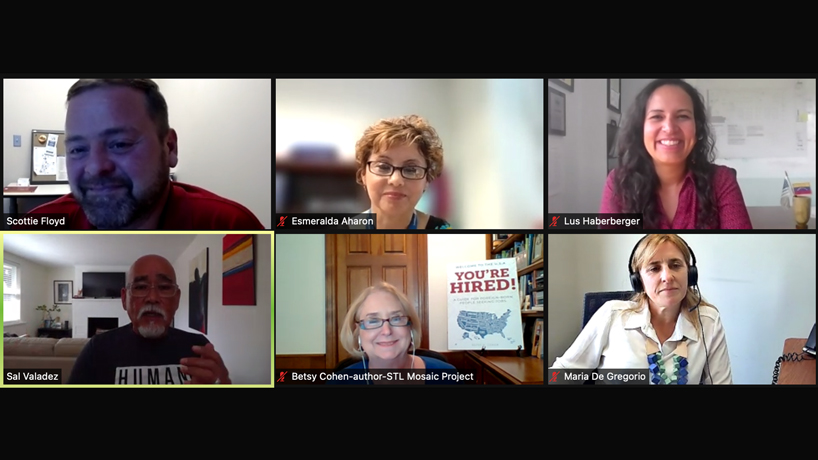
Career Services Coordinator Scottie Floyd moderated a panel discussion on inclusion in the workforce with Esmeralda Aharon, Betsy Cohen, Lusnail Rondόn Haberberger and Sal Valadez as part of Hispanic Heritage Month. Maria DeGregorio, a business counselor with the Hispanic Chamber of Commerce of Metropolitan St. Louis was among the attendees. (Screenshot)
More and more businesses are celebrating their diversity as they signal steps to create more inclusive teams.
The University of Missouri–St. Louis held a panel discussion last Wednesday via Zoom to help students and faculty members gain insight and discover strategies to target truly inclusive workplaces. The program was held as part of UMSL’s observance of Hispanic Heritage Month, coordinated through the Office of Student Involvement.
Career Services Coordinator Scottie Floyd moderated the discussion between panelists Esmeralda Aharon, the program director of staff and community engagement for the Office of Diversity, Equity, and Inclusion for the Saint Louis University School of Medicine; Betsy Cohen, the executive director St. Louis Mosaic Project; Lusnail Rondόn Haberberger, the founder of electrical engineering consulting firm LUZCO; and Sal Valadez, the representative for diversity, outreach and marketing for the Missouri-Kansas District Council of the Laborers’ International Union of North America.
“We talk about celebrating diversity, equity and inclusion, but those are only concepts if they are not placed into action,” Valadez said. “In other words, each one of those categories requires an action. The diversity part is understanding that our workforce includes people from many perspectives and from many backgrounds. The equity piece is in terms of what policies are in place and the practice within the workplace. The inclusion piece is really the most critical piece, which means that you actually have actions. So, beyond having a diversity statement, your workforce actually is inclusive of many people.”
When evaluating potential employers, Valadez recommended doing some research to try to see if a business’s board of directors and workforce matches its statements on diversity.
Cohen leads a regional initiative within the St. Louis Economic Development Partnership and the World Trade Center St. Louis to make St. Louis a cultural mosaic by supporting immigrants to help invigorate the region. Cohen, author of a new book titled, “Welcome To the U.S.A. – You’re Hired!,” said companies have incentive in today’s labor market to search for more diverse employees.
“It’s a very good time right now because so many employers are desperate to hire, and that’s causing them to look more deeply at what they’ve done in the past and what they need to do differently to get a different workforce,” Cohen said. “They have to look at the trends, but we talk to them about their materials done. Is there something that they might need to put into a different language? Do they have people who are in their workforce, much less their leadership or their boards that, in this case, would be Hispanic? Because there’s a saying that if you can see it, you can be it.”
Haberberger’s company, LUZCO, is one of the fastest growing in the St. Louis region. She was asked how her recruitment has changed over time and how she keeps diversity at the forefront of those efforts.
“It’s more involved with the community, word of mouth and a lot of advertising of course in social media,” Haberberger said. “We don’t look obviously only for people with different nationalities. We look for the best talent. It just happens that because of the connections and the network we have, we tend to get a lot of people from different backgrounds – not only ethnicity but also professional backgrounds.”
Aharon reminded that recruiting is only the first at building an inclusive workplace.
“Once you recruit, maintaining and retaining those employees is so critical because, if those employees leave, you will then be faced with retraining new employees, and that is not cost effective for businesses,” she said. “We define diversity as the differences at the table, equity as the access to potential outcomes, and inclusion as the voice at the table. So, we want our underserved, underrepresented minorities to have that voice, and for us to ask them, ‘What do you need?’ and survey them. If companies are not able to adjust their practices and policies, those diverse employees may not retain. They won’t be able to keep them.”














